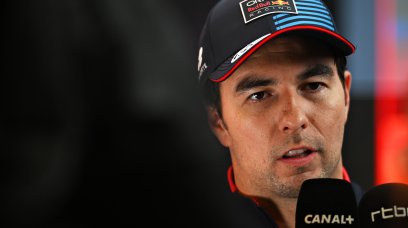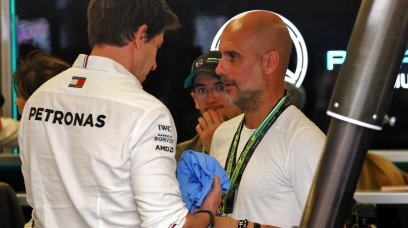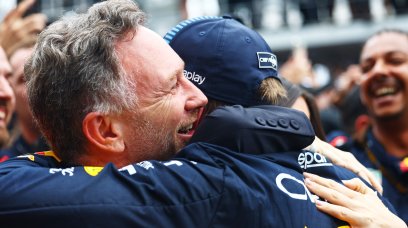The rain that threatened to cause chaos at the start of the Dutch Grand Prix pushed the abilities of all 20 Formula 1 drivers to the limit - but no one shone through brighter than Fernando Alonso. A common theme throughout Alonso’s successful first season with Aston Martin is the strength of his performances while in his early 40s. Drivers who slip into retirement once they reach a certain age tend to see their reactions fluctuate prior to their decision, and Alonso is certainly beyond the average threshold for an F1 driver. But the opening segment of the Zandvoort race was another example of how his prowess, which has brought him 32 Grand Prix wins and two F1 World Championships, has not yet deteriorated. "There are some drops of rain," Alonso noted over the team radio as he came around the final corner of the formation lap. Having informed his driver prior to the warm-up lap that rain was on the way, Alonso’s race engineer Chris Cronin provided an immediate update: "The heaviest rain will hit sector three, it could be on this first lap." Alonso held position on the run into the first corner, but his astute racecraft saw him sail around the outside of Alexander Albon at Turn 2. Moments later he projected his car onto the low line at the banked Turn 3 to move ahead of George Russell. In the space of three corners, he had changed his fifth-place starting position into a spot on the podium. "It’s definitely wetter in sector three, caution sector three," Cronin then informed Alonso. "We think it’s going to be OK, it’s lighter in the pit lane." But the track was beginning to get ever more saturated as the lap wore on and Alonso had his first real indication of that at Turn 12. As he exited the corner, the Spaniard suffered a stab of wheel spin which prompted the first real discussion with his engineer regarding a switch to a wet weather tyre. Alonso: "It’s very wet here." Cronin: "Yeah, it’s raining a bit harder now in the pit lane. We are ready." Alonso: "Maybe Inters?" Cronin: "It’s only two or three minutes this rain, two or three minutes." Behind, seven drivers opted to come into the pits and switch to Intermediate tyres as it was clear it was the preferable compound to be on. However, Aston Martin was cautious that the shower was not going to be long-lasting as it weighed up an extra pit stop against time lost while navigating the circuit on the wrong tyre for a handful of laps. Alonso found himself closely tailing Lando Norris for second place as they began the second lap. Through the first sector, Alonso was a full second faster than the McLaren driver - and even more impressively, despite being stuck in the spray of Norris, he was 0.004s faster than Verstappen who had a clear track ahead of him. Alonso then opted to pull his car back down to the low line at Turn 3 once again, with Norris running the more traditional high line.
Alonso's Inter call
Although it risked getting his car out of shape and into a spin in the slippery conditions, Alonso made it work. Not only did he safely see himself through the corner, he easily out-tractioned Norris and completed the overtake. A decision had to be made at Aston Martin. If it didn’t pit at the end of the second lap, it would have to commit to holding out until the race eased off - a strategy that many drivers adopted. As he approached Turn 7, Alonso once again brought up the topic of a tyre switch. Alonso: "At the moment, we would be faster on Inters." Cronin: "Yeah, definitely. We only expect two or three minutes of this but it’s definitely wet now." Alonso: "OK, so we can wait another." Cronin: "It’s getting lighter now. Can we survive this, do you think?" Alonso: "Survive? Yes?" Cronin: "Careful at [Turn] 11 now, smooth tarmac." But while the impending decision hung in the balance, which would likely decide the outcome of its race, Alonso had closed in on Verstappen. Through the middle sector that was littered with water, Alonso was a full six-tenths faster than the Red Bull driver, who was also discussing strategy options with his engineer Gianpiero Lambiase. It’s in these circumstances that experience counts for so much, and with every F1 car on a knife edge, it’s down to the driver to navigate the difficulties and make the difference to ensure success. Keeping his car pointed in the right direction while also closing in on the race lead spoke volumes as to the driver that Alonso continues to be, 22 years deep into his F1 career. The decision to make the pit stop was made very late, while Red Bull had made its call early on in the lap. As he came through Turn 12, Aston Martin initially left the decision in Alonso’s hands. Cronin: "You let us know if you want to come in. It’s still raining a bit but the pit lane is lighter." Alonso: "I think I can survive." Cronin: "It’s one minute or so. Follow those other cars." Alonso was content to stick it out on the slick tyres and continue in the wicked conditions, but the team called on him to pit as he rounded the corner as it saw Red Bull preparing to stop. It was an important decision as it kept Alonso in tune with the leaders and helped carry him to his seventh podium of the campaign. But just as pivotal was the skill of the driver behind the wheel, whose sharpness and confidence has not waned with age. He ensured that by making crucial overtakes in difficult conditions, he placed the car into position to deliver on a day when the line between success and failure was so fine.
Most read


















